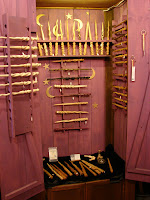 Whenever we passed one of Glacier's lakes by car, my husband knew I would want to stop if the reflection was just right. I love seeing the mountains and shorelines in the water. Walking near Many Glacier Hotel, Mount Gould and Mount Henry were frequent reflections captured on my camera.
Whenever we passed one of Glacier's lakes by car, my husband knew I would want to stop if the reflection was just right. I love seeing the mountains and shorelines in the water. Walking near Many Glacier Hotel, Mount Gould and Mount Henry were frequent reflections captured on my camera.My reflections stretched to the people I met, wondering how the folks seated next to us at a restaurant could have the same interests and mutual connections, how one woman by the fireplace could share my thoughts about the environment and ecology, how a couple on the Iceberg Lake trail could be from the suburb next to ours, how the Lithuanian young people we came to know at an East Glacier store chose to come here for the summer.
All coincidences? Perhaps. But the last one echoed in my reflections. Something about Lithuania intrigued me. Then I came home and got the books on my reserve list from the library. One was Between Shades of Gray by Ruta Sepetys, and it is told by a fifteen-year-old Lithuania girl who is deported from her country on June 14, 1941 by the Soviets. The horrors she witnesses along with her mother and younger brother are atrocious. All the while, she draws and records information in hopes of notifying her father (in a prison camp) of their whereabouts. Interspersed with Lina's experiences and observations are memories of events that relate to her 1941 thoughts, all of which help her understand how her family came to be in this circumstance with thousands of others.
Despite the horrible actions of the Soviet soldiers and the awful conditions, Lina and her companions fought for their dignity as humans and strove to give nothing to their captors, not even their fear. She is a credible, conscientious narrator, and I loved her for her honesty and determination.
Take time to read this book. I finished it this morning. I immediately turned on the computer to learn more about the Soviet occupation of Lithuania and its renewed independence in the early 1990s. How could I have missed all of this important information as a young person? It is another reminder to pay careful attention to world events and the people affected by them.














